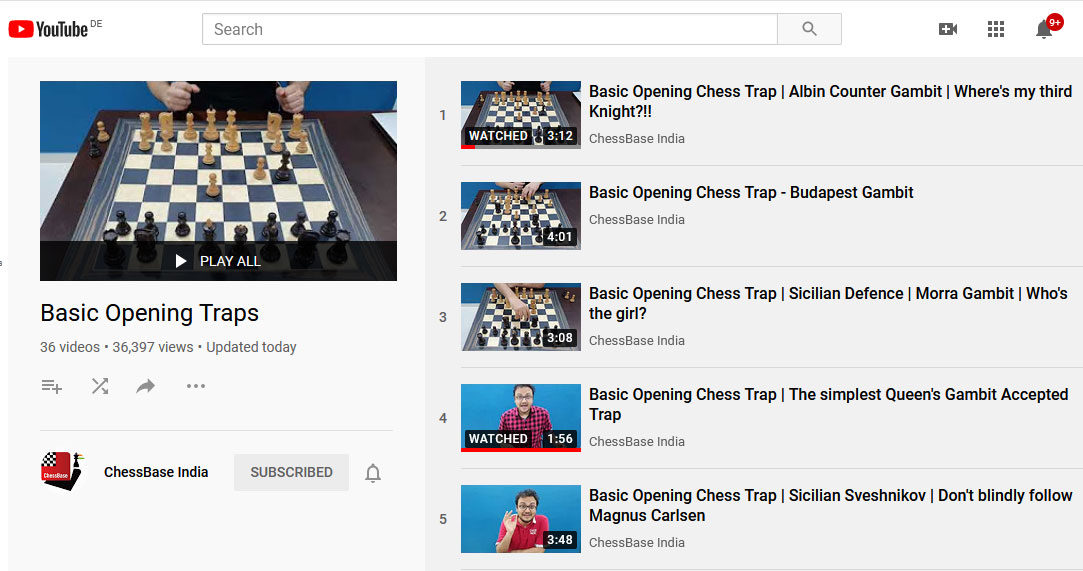.jpeg)

.jpeg)
The new Opening Encyclopaedia offers fast access to all openings. Openings are sorted via the menu by name & ECO Code for fast and easy access to your favorite openings.
In a recent interview with the German magazine SCHACH I answered one question thus:
14. Which is the most interesting chess game you have ever played?
I have never reached a playing strength of 2000 Elo. For one year I played in a local club in Hamburg and won two nice games, which I can't reconstruct anymore. In my early youth I used a single opening trap paired with skilful facial expressions ("Did I just make a dreadful mistake?") to win a dozen games.
In the feedback section below the interview one reader wrote: "Was it with ...Nd4?" I have no idea who this reader was, and especially how he could have guessed correctly. My current theory is that it must have been a member of the same chess club, and he had seen me doing it live, decades ago!
So here is the trap I used, when I started playing competitive chess in my early teens:
1.e4 e5 2.Nf3 Nc6 3.Bc4. A common opening, popular at the time. My opponent wants to play "Italian." 3...Nd4?! If you are curious, this opening trap even has a name: the Blackburne Shilling Gambit.
In the above live diagram I have set a chess engine to reply to moves you enter with white. If you follow the moves I give below, and walk into the trap lines, it will execute everything flawlessly.
So here is how it works: you can't resist and play 4.Nxe5. It's a free pawn. The engine will answer 4...Qg5, attacking your knight. But wait a minute, isn't there a family check: 5.Nxf7, forking the queen and rook! The engine will reply 5...Qxg2, threatening to take the h1 rook, which naturally must move. But after 6.Rf1 there follows 6...Qxe4+. Now White can simply give up the queen (7.Qe2 Nxe2). So it is better to play 7.Be2, isn't it? No, because that gives Black a truly dramatic finish: 7...Nf3#. This is a "suffocated mate," something you rarely get to execute in a lifetime. And I managed to do it a dozen times!
Here's the cutest little girl telling us how to play the the Blackburne Shilling Gambit.
My colleague Sagar Shah has very nicely described the gambit in the above video. And here's the annotated opening trap on a replay board. Note you can click on the fan button to start an engine and analyse different lines.
Actually you need some acting skills to pull this one off. As described in the annotated game above, on move three you grasp the knight carelessly and move it to b4. You do not let go, look alarmed, and then suddenly change your mind: you place the knight to d4, looking quite unhappy about it.
It is also important to play 4...Qg5 impulsively, and to stare at the knight on e5 while doing so. Your expression should say: "Now you have to retreat the knight, or I am going to take it." As soon as you let go of the queen glance at f7 and try to conceal your horror. Make your opponent feel good when he sees what you have seen: the fork. For me, in fledgling years, the gambit worked more often than not. On a few occasions I got applause.
I also tried this gambit on some strong players. Once, when travelling in a car, I challenged IM David Levy to a blindfold game. He was not really thinking and walked into the trap. But he quickly saw what I was planning and played 5.Bxf7 Kd8 6.0-0, after which I had a better position. But in the end I lost, because he was a so much better player than me. Another time, again in a car, I challenged a 16-year-old boy to a fun blindfold game. Here my acting entailed saying "Knight to ... er, wait a sec, no, okay, to d4." My opponent simply grinned and played 4.Nxd4, without any hesitation. The young IM Nigel Short knew traps! I resigned in a hopelessly lost position ten moves later.
The subject of my early youth escapades came up because my friend and colleague, Sagar Shah, CEO of ChessBase India and YouTube chess king, had started a new channel on opening traps:

In his series Basic Opening Traps the indefatigable Sagar has, in 40 days, recorded 38 lessons. His videos are just a couple of minutes long and have had between 50,000 and 130,000 views. So you'd better take a look – otherwise you may fall into one of the traps on your next club tournament.
Here, to start you off, are a few nice little samples. If you have found a taste for the smothered mate you will do well to start with this one:
One more smothering trap?
Here's a nice little one in the Albin Countergambit:
And here's a basic trap in the Queen's Gambit
So now you have learned five opening traps from Sagar – there are 33 left to go. My advice to you: watch the videos multiple times, so you actually remember the ideas. You can have a very pleasant few hours seriously improving your results on club evenings.
And if you are hooked here are some interesting DVD/Fritztrainers by GM Nigel Davies.